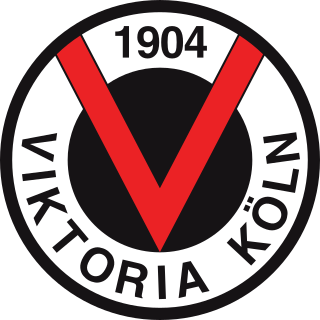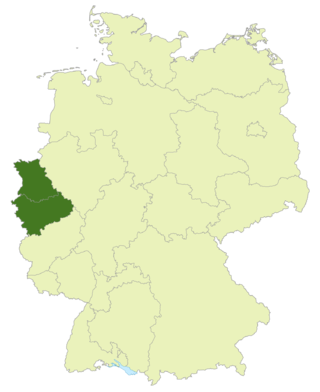
Wuppertaler SV is a German association football club located in Wuppertal, North Rhine-Westphalia. The city was founded in the year of 1880 by the union of a number of smaller towns including Elberfeld, Barmen, Vohwinkel, Cronenberg and Ronsdorf – each with its own football club. Wuppertal Sport Verein was formed on 8.July 1954 out of the merger of TSG Vohwinkel and SSV Wuppertal and was later joined by Borussia Wuppertal to form the present day club. In addition to the football side, today's sports club includes departments for boxing, gymnastics, handball, and track and field.

FC Viktoria Köln is a German association football club from the city of Cologne in North Rhine-Westphalia, that competes in the 3. Liga, the third tier of German football.

The Oberliga Südwest was the highest level of the German football league system in the southwest of Germany from 1945 until the formation of the Bundesliga in 1963. It covered the two states of Rhineland-Palatinate and Saarland.

The 2. Bundesliga Nord was the second-highest level of the West German football league system in the north of West Germany from its introduction in 1974 until the formation of the single-division 2. Bundesliga in 1981. It covered the northern states of North Rhine-Westphalia, Lower Saxony, Bremen, Hamburg, Schleswig-Holstein and the city of West Berlin.

The Regionalliga West was the second-highest level of the German football league system in the west of Germany from 1963 until the formation of the 2. Bundesliga in 1974. It covered the state of Nordrhein-Westfalen, the most populous state of Germany.
The Amateurliga Saarland was the highest football league in the state of Saarland and the third tier of the German football league system from 1951, when the clubs from the Saar returned to Germany, until the formation of the Oberliga Südwest and the Verbandsliga Saarland below it in 1978.
The Regionalliga West/Südwest was the third tier of the German football league system in the states of Saarland, Rheinland-Pfalz and Nordrhein-Westfalen from 1994 to 2000.
The Oberliga Nord was the highest level of the German football league system in the north of Germany from 1947 until the formation of the Bundesliga in 1963. It covered the states of Lower Saxony, Bremen, Hamburg and Schleswig-Holstein.
The Oberliga Berlin, sometimes also referred to as Stadtliga Berlin or Vertragsliga Berlin was the highest level of the German football league system in the city of West Berlin in West Germany from 1945 until the formation of the Bundesliga in 1963. It was by far the smallest of the five Oberligas.

The Oberliga Nordrhein was the highest Football League in the region of Nordrhein which is part of the state of North Rhine-Westphalia from 1978 to 2008. In its last season, it was one of nine Oberligas in German football, the 4th tier of the German football league system. In 2008, it was replaced by the NRW-Liga, a new statewide league.

The Gauliga Westphalia was the highest football league in the Prussian province of Westphalia and the small Free State of Lippe from 1933 to 1945. Shortly after the formation of the league, the Nazis reorganised the administrative regions in Germany, and the GaueWestphalia-North and Westphalia-South replaced the Prussian province and the Free State.

The Gauliga Niederrhein was the highest football league in the northern part of the Prussian Rhine Province from 1933 to 1945. Shortly after the formation of the league, the Nazis reorganised the administrative regions in Germany, and the GaueEssen and Düsseldorf replaced the Prussian province in the Lower Rhein region.

The Gauliga Mittelrhein was the highest football league in the central and southern part of the Prussian Rhine Province from 1933 to 1945. Shortly after the formation of the league, the Nazis reorganised the administrative regions in Germany, and the GaueKöln-Aachen and Moselland replaced the Prussian province in the Middle Rhine region.
The 1978–79 season was the third time Tennis Borussia Berlin played in the 2. Bundesliga, the second highest tier of the German football league system. After 38 league games, Tennis Borussia finished 11th in the division, following a tenth-placed finish the previous year. The club reached the third round of the DFB-Pokal; losing 2–0 at home to 1. FC Nürnberg. Allan Hansen and Norbert Stolzenburg each scored 11 league goals during the season.
The 1979–80 season was the fourth time Tennis Borussia Berlin played in the 2. Fußball-Bundesliga, the second highest tier of the German football league system. After 38 league games, Tennis Borussia finished 13th in the division, following an eleventh-placed finish the previous year. The club lost in the first round of the DFB-Pokal; going out 1–0 away to SC Viktoria 04 Köln. Norbert Stolzenburg scored 24 of the club's 57 league goals.
The Introduction of the Bundesliga was the long-debated step of establishing a top-level association football league in Germany in 1963. The new league, the Bundesliga, played its first season in 1963–64 and continues to be the highest league in the country. Its introduction reduced the number of first division teams in Germany from 74 to 16 and finally eliminated the problem of the top-teams having to play uncompetitive teams in regional leagues.
The Introduction of the 2. Bundesliga was the step of establishing a professional second tier association football league in Germany in 1974. The new league, the 2. Bundesliga, played its first season in 1974–75 and continues to be the second-highest league in the country. Its introduction reduced the number of second divisions in Germany from five to two and the number of teams at this level from 83 to 40. It eliminated the necessity of having a promotion round at the end of the season to determine the two teams promoted to the Bundesliga.

The 1956–57 Oberliga was the twelfth season of the Oberliga, the first tier of the football league system in West Germany and the Saar Protectorate. The league operated in five regional divisions, Berlin, North, South, Southwest and West. The five league champions and the runners-up from the west, south, southwest and north then entered the 1957 German football championship which was won by Borussia Dortmund. It was Borussia Dortmund's second national championship, having won its first in the previous season and thereby becoming the first club to win back-to-back championships since Dresdner SC in 1943 and 1944.
The Western German Cup was a cup competition organised by the Western German Football Association, which was played from the 1949–50 season up to the 1973–74 season. The best teams then qualified for the following season of the DFB-Pokal. In the years 1954 to 1960, only the Western German Cup winner participated in the DFB-Pokal. In the 1954–55 season, there was no competition.
Dominik Ernst is a German professional footballer who plays as a right-back for Fortuna Köln.








